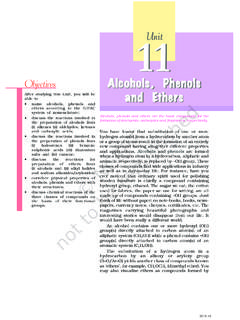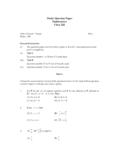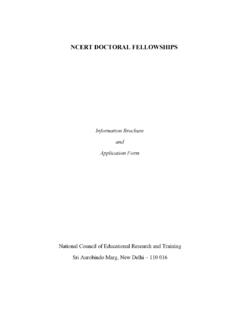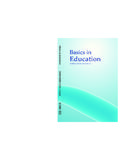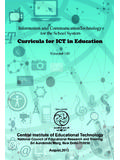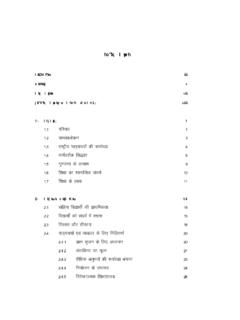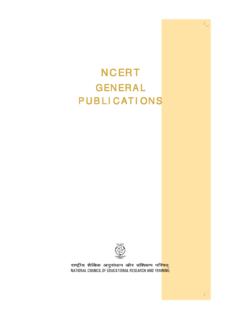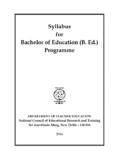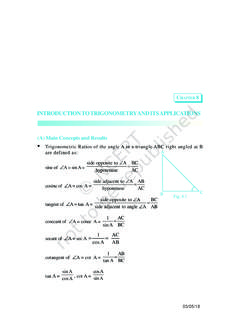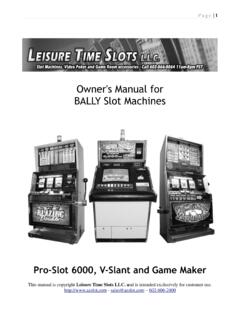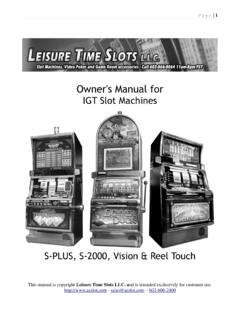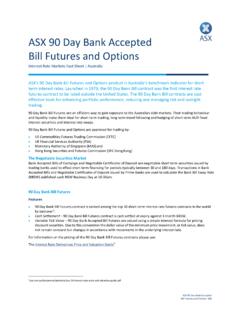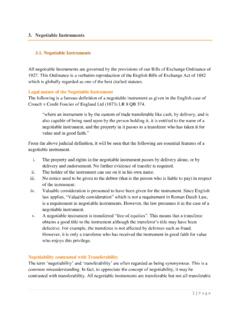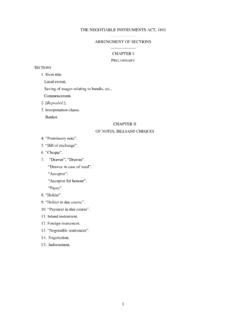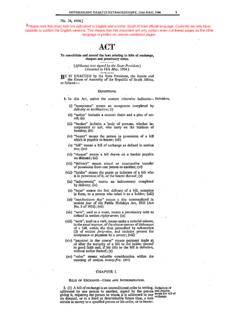Transcription of Bill of Exchange - NCERT
1 Goods can be sold or bought for cash or oncredit. When goods are sold or bought forcash, payment is received immediately. On theother hand, when goods are sold/bought on creditthe payment is deferred to a future date. In such asituation, normally the firm relies on the party tomake payment on the due date. But in some cases,to avoid any possibility of delay or default, aninstrument of credit is used through which thebuyer assures the seller that the payment shall bemade according to the agreed conditions. In India,instruments of credit have been in use since timeimmemorial and are popularly known as hundies are written in Indian languages andhave a large variety (refer box1).
2 Box 1 Hundies and its TypesThere are a variety of hundies used in our us discuss some of the most common Hundi: This is drawn by one merchant onanother, asking the latter to pay the amount to aShah. Shah is a respectable and responsible person,a man of worth and known in the bazaar. A shah-joghundi passes from one hand to another till it reachesa shah, who, after reasonable enquiries, presents itto the drawee for acceptance of the Hundi: This is hundi payable at sight. Itmust be presented for payment within a reasonabletime after its receipt by the holder. It is similar to ademand OBJECTIVESA fter studying this chapter,you will be able to : state the meaning ofbill of Exchange and apromissory note; distinguish between abill of Exchange and apromissory note; state the advantagesof bill of Exchange ; explain the meaning ofdifferent terms involvedin the bill transaction, record bill of exchangetransactions injournal; record transactionsrelating to dishonour,retirement and renewalof bill ; describe the uses ofbill receivable and billpayable book.
3 State the meaning anduse of of Exchange82022-23278 AccountancyMuddati Hundi: A muddati or miadi hundi is payable after a specified period of is similar to a time are few other varieties of hundies like Nam-jog hundi, Dhani-jog hundi, Jawabeehundi, Hokhami hundi, Firman-jog hundi, and so a days these instruments of credit are called bills of Exchange orpromissory notes. The bill of Exchange contains an unconditional order to paya certain amount on an agreed date while the promissory note contains anunconditional promise to pay a certain sum of money on a certain date. InIndia these instruments are governed by the Indian Negotiable InstrumentsAct Meaning of bill of ExchangeAccording to the Negotiable Instruments Act 1881, a bill of Exchange is definedas an instrument in writing containing an unconditional order, signed by themaker, directing a certain person to pay a certain sum of money only to, or tothe order of a certain person or to the bearer of the instrument.
4 The followingfeatures of a bill of Exchange emerge out of this definition. A bill of Exchange must be in writing. It is an order to make payment. The order to make payment is unconditional. The maker of the bill of Exchange must sign it. The payment to be made must be certain. The date on which payment is made must also be certain. The bill of Exchange must be payable to a certain person. The amount mentioned in the bill of Exchange is payable either ondemand or on the expiry of a fixed period of time. It must be stamped as per the requirement of bill of Exchange is generally drawn by the creditor upon his debtor. It has tobe accepted by the drawee (debtor) or someone on his behalf.
5 It is just a drafttill its acceptance is example, Amit sold goods to Rohit on credit for ` 10,000 for three months. Toensure payment on due date Amit draws a bill of Exchange upon Rohit for` 10,000 payable after three months. Before it is accepted by Rohit it will be calleda draft. It will become a bill of Exchange only when Rohit writes the word accepted on it and append his signature thereto communicate his of Parties to a bill of Parties to a bill of Parties to a bill of Parties to a bill of Parties to a bill of ExchangeThere are three parties to a bill of Exchange :(1)Drawer is the maker of the bill of Exchange . A seller/creditor who is entitledto receive money from the debtor can draw a bill of Exchange upon thebuyer/debtor.
6 The drawer after writing the bill of Exchange has to sign itas maker of the bill of Exchange .(2)Drawee is the person upon whom the bill of Exchange is drawn. Drawee isthe purchaser or debtor of the goods upon whom the bill of Exchange isdrawn.(3)Payee is the person to whom the payment is to be made. The drawer ofthe bill himself will be the payee if he keeps the bill with him till the dateof its payment. The payee may change in the following situations:(a)In case the drawer has got the bill discounted, the person who hasdiscounted the bill will become the payee;(b)In case the bill is endorsed in favour of a creditor of the drawer, thecreditor will become the , the drawer and the payee is the same person.
7 Similarly, the draweeand the acceptor is normally the person. For example, Mamta sold goods worth`10,000 to Jyoti and drew a bill of Exchange upon her for the same amount payableafter three months. Here, Mamta is the drawer of the bill and Jyoti is the drawee. Ifthe bill is retained by Mamta for three months and the amount of ` 10,000 isreceived by her on the due date then Mamta will be the payee. If Mamtagives awaythis bill to her creditor Ruchi, then Ruchi will be the payee. If Mamta gets this billdiscounted from the bank then the bankers will become the the above mentioned bill of Exchange , Mamta is the drawer and Jyoti isthe drawee. Since Jyoti has accepted the bill , she is the acceptor .
8 Suppose inplace of Jyoti the bill is accepted by Ashok then Ashok will become the Your Understanding - IWrite True or False against each statement regarding a bill of Exchange :(i)A bill of Exchange must be accepted by the payee.(ii)A bill of Exchange is drawn by the creditor.(iii)A bill of Exchange is drawn for all cash transaction.(iv)A bill payable on demand is called Time bill ;(v)The person to whom payment is to be made in a bill or Exchange is calledpayee.(vi)A negotiable instrument does not require the signature of its maker.(vii)The hundi Payable at sight is called Darshani hundi.(viii)A negotiable instrument is not freely transferable.(ix)Stamping of promissory note is not mandatory.
9 (x)The time of payment of a negotiable instrument need not be Promissory NoteAccording to the Negotiable Instruments Act 1881, a promissory note is definedas an instrument in writing (not being a bank note or a currency note), containingan unconditional undertaking signed by the maker, to pay a certain sum ofmoney only to or to the order of a certain person, or to the bearer of theinstrument. However, according to the Reserve Bank of India Act, a promissorynote payable to bearer is illegal. Therefore, a promissory note cannot be madepayable to the definition suggests that when a person gives a promise in writing topay a certain sum of money unconditionally to a certain person or according tohis order the document is called is a promissory features of a promissory note emerge out of the above definition: It must be in writing It must contain an unconditional promise to pay.
10 The sum payable must be certain. It must be signed by the maker. The maker must sign it. It must be payable to a certain person. It should be properly promissory note does not require any acceptance because the maker of thepromissory note himself promises to make the Parties to a Promissory Parties to a Promissory Parties to a Promissory Parties to a Promissory Parties to a Promissory NoteThere are two parties to a promissory note. Maker or Drawer is the person who makes or draws the promissory noteto pay a certain amount as specified in the promissory note. He is alsocalled the promisor. Drawee or Payee is the person in whose favour the promissory note isdrawn. He is called the , the drawee is also the payee, unless, it is otherwise mentioned in thepromissory note.
